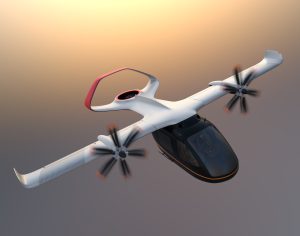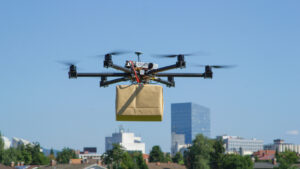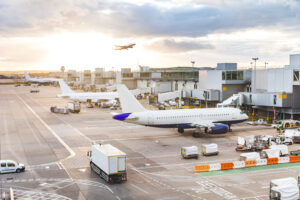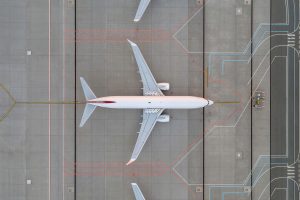AAM Industry Insights with Alton Experts
Join our AAM experts, Joshua Ng and Alan Lim, as they share insights on the podcast hosted by ‘eVTOL Insights.’ In this episode, Joshua and Alan cover Alton’s expanding role in the AAM space, discuss the upcoming Singapore Airshow Mobility Forum, and provide an outlook for AAM in 2024.
The discussion also delves into the unique use case of airport shuttles, emphasizing entry into service considerations with the latest article published by Alton.
Discover more about our work in the Advanced Air Mobility market and get a preview of what’s in store for the AeroForum program at the Singapore Airshow.
Podcast Transcript
[This transcript has been edited for clarity and length]
[1:30] Question: Can you briefly introduce yourselves?
Joshua: I’m currently a Director at Alton Aviation Consultancy where I lead the technology and mobility practice globally for the firm. I started my career at ST Aerospace, which is one of the largest independent MRO providers in the aviation sector. My roles at the company extended across different parts of the value chain, including customer account management and supply chain management.
I moved into consulting about eight years ago and have been similarly working across the aviation space, with airlines, with airports, with investors, and many other different stakeholders in the value chain. I think like most of us in the firm, we have all been bitten by the aviation bug. We all have an origin story that has something to do with planes. And that’s why I started my career in aviation and choose to continue to be in the aviation sector with Alton.
Alan: I’m a Director here at Alton’s Singapore office and together with Joshua spend a significant amount of time in the technology and mobility practice, focusing on advanced air mobility (AAM) and new technologies. I have an airline background – having started my career with Singapore Airlines on the operations side of the business, looking at things like policies for airport operations, on-time performance. Subsequently, I moved into the commercial side of the house, looking at the e-commerce distribution channels, and finally ending my time at Singapore Airlines in a business transformation role.
During Singapore Airlines’ three year long business transformation program, I experienced a taste of consulting, and decided to move into management consulting, which is what I’ve been doing for about five years now. Like Joshua mentioned, I have a good origin story and here at Alton find myself doing what I like and helping our clients figure out the biggest questions in the industry.
[4:25] Question: What is Alton’s role in the emerging AAM market?
Joshua: Alton works on consulting projects across the entire aviation sector, and we characterize the work we do in the AAM space as being at the intersection of what we would call traditional aviation and “new aviation”. For traditional legacy players, we help them understand what’s to come and we help them to understand their go-to-market strategies and how they can participate and partner in the sector. For the new players entering the aviation sector for the first time, we also help them on the same topics, but from an “outside-in” perspective, and we help them try to navigate the intricacies, challenges, and regulatory environment that characterize the aviation sector.
Alan: Adding to Joshua’s point, we help players understand topics such as “what is the market size, what is addressable, what are the growth prospects, is the technology viable, what are the ways to commercialize these products”. In addition to our expertise in the traditional aviation space, we also have a deep understanding of the ongoing developments in the AAM space, so that we can offer industry insights and outlook, given that this is a fast-changing industry landscape.
[8:40] Question: As Alton is moderating the AeroForum at the Singapore Airshow from February 20th to 25th, can you share a bit about what is expected from the panels?
Joshua / Alan: We have been preparing for the Airshow for probably about six months, and what we have sought to bring different stakeholders from across the value chain, across different geographies, and not only focus on Asia but from an international perspective as well, to bring their wealth of expertise and insights to the show.
At the very first session (February 20th), we’ll bring in very prominent C-suite executives from the different AAM OEMs to share their views on what the sector’s future trajectory is, and what are some of the challenges as the industry marches towards commercialization.
We will also cover topics like trying to understand the nuances of using AAM vehicles for international travel, and trying to understand from the different operators what kind of operating models they are looking to adopt as they bring their aircraft into commercialization and into service.
And finally, but not the least, we will also try and understand from them with so much promise and so much opportunity, really, what are the different pieces that have to come into place to enable the entire ecosystem.
Session 1:
February 20th 3.30pm – 4.30pm
“AAM INDUSTRY EXECUTIVES FORUM”
(Attendees include CCO from Archer, CFO from Electra, CEO from EVE, CDO from SkyDrive, and CCO from Vertical)
Session 2:
February 21st 10.30am – 11.30am
“AAM BEYOND BORDERS – HOW DO WE ENABLE INTERNATIONAL TRAVEL”
Session 3:
February 21st 1.30pm – 2.30pm
“AAM OPERATING MODELS – COMPLETE, COMPETE, OR COMPLETELY DIFFERENT”
Session 4:
February 23rd 11.00am – 12.00pm
“DEVELOPING THE AAM ECOSYSTEM – THE JOURNEY SO FAR AND THE JOURNEY AHEAD”
[For more information on the AeroForum panels at Singapore Airshow, please visit here]
[15:15] Question: Alton recently published an article about AAM entry into service considerations and the use case of airport shuttle, can you share more details about it?
Joshua / Alan: When we wrote the article, we wanted to try and understand the vehicle use cases. One of the use cases was the airport shuttle service, taking passengers from the airport into the downtown city and vice versa. This mode of transport is not new today. In airports in New York, there are helicopter services that can bring slightly more well-heeled passengers or business people who are short on time to bypass traffic and get them from point A to point B or from the airport to point B in the shortest amount of time. If we look at Asia, Manila, Kuala Lumpur, Jakarta, and Bangkok are markets where there’s a lot of opportunity to apply this use case and to bring a lot of value and a lot of benefit to the residents today.
eVTOLs today are not designed to travel far and at a very fast speed. Given these lower payload range capabilities, they would be very ideal to serve these shorter haul, but higher frequency routes between the airport and the city center. Airports need to think about how they can integrate this form of service into the entire concept of operations, how they can move from the current mode of transport, maybe ground transportation, rail transportation, and include an additional form of eVTOL transportation into the whole ecosystem to connect passengers to and from the airport. As we explore these different use cases, we also explore the different considerations that different stakeholders in the value chain would need to then think about and prepare for as we move towards the entry into service of these vehicles in the next one, two, or even three years.
The other dimension that needs to be considered is the fact that these are high volume routes. There’s a lot of passengers going between two points. One vertiport at the airport and another in the city would establish a regular schedule where operators can start to have high utilization of the vehicles, bring down the cost, and eventually open this service up to a wider demographic profile of travelers.
[21:10] Question: What are some of the problems that Alton’s clients have asked to solve?
Joshua: There are different sets of questions that are asked by different stakeholders. If you look at policymakers, they tend to ask questions about safety.
- Are the vehicles safe to operate in the urban environment?
- Are there fail-safe mechanisms in case something goes wrong?
- Should we even have eVTOLs in our neighborhoods?
- Would they be a public nuisance or would they be a public benefit?
While there are no easy answers to the questions, we will be more likely to get those answers as the first prototypes start flying in neighborhoods and in residential areas where people can look, see, and feel the eVTOLs in their own presence.
I would also like to bring out is the fact that building up a transportation infrastructure around eVTOLs must be considered. How many vehicles are you going to have? How many vertiports are you going to have? What kind of infrastructure are you going to plan for? Those are questions linked to the demand of such a service. And I think we do have quite a sizable repertoire of tools and models that help us understand the travel patterns within the city and between cities to help understand some of the potential scenarios in the future of how eVTOLs will grow and develop in metropolitan areas.
Alan: The bigger question that we are frequently asked is about the size of the addressable market:
- How big of an AAM market (for operators or OEMs) is there?
- What would the network look like?
- How much will that generate in terms of revenue and what kind of fleet size will be needed for an operator?
- And then for an OEM, how many vehicles could I possibly sell within this specific market?
[25:15] Question: What is your / Alton’s outlook for 2024?
Alan: We’ve seen progress with EHang getting its certification from the CAAC late in 2023. But what we’ll see in 2024 is that some of the front-running western OEMs will likely make very significant progress toward their type certification. And many of them are looking toward 2025 to get their vehicle certified – the likes of Joby and Beta. Even in the Asia Pacific market – Autoflight is one, but there’s also Aerofugia, which is a Chinese OEM that has already started its type certification process with the CAAC in the hopes of getting its vehicles certified shortly.
On the operations front, that’s where it gets a little bit more interesting. After EHang’s certification, they have laid out plans to launch aerial tourism and sightseeing services within China. We talked about social acceptance previously, so that’s important. The industry will certainly be very interested to see the reception from the public. More importantly, it’s also for it to demonstrate the safety, the reliability, and how such a use case might play out around the world when we get more vehicles being certified in countries like Japan and South Korea.
In 2024, we will get a lot more clarity on both the regulatory certification frameworks for AAM operations in these jurisdictions, and a greater number of partnerships between both the public and the private stakeholders to make this a reality. It’ll be interesting to watch, particularly in Asia. Some of these governments, operators, and OEMs are pushing forward their plans to get things into service.
Joshua: If there is a word to describe 2024, it is “anticipation”. I think there will be a lot of announcements pointing to how the future direction of the AAM space will be. And so I’m looking in anticipation at what EHang will be doing in China. They obviously have their certificates in place now. It’s really about putting passengers in the vehicle and operating them safely on their first use case.
I’m also looking in anticipation what’s going to happen in Japan and Korea, both front runners and leaders in the AAM space, especially with Japan and the World Expo next year, and how that will play out in terms of operational use case in the city environment.
And then also in Australia and New Zealand, where the use case is slightly different. It’s a lot more cargo, a lot of remotely piloted UAV operations, UAS operations, which I think portend to how the sector might develop, not in the next few years, but in the next 10 to 15 years as autonomous technology becomes a lot better, sensing and avoiding technology becomes better, and we might eventually see a vehicle where it’s remotely piloted or assisted in the future.
[31:55] Question: What are your final thoughts?
Joshua: Just to reiterate, I think the rubber is starting to hit the road, and we have said that in 2023, and I think we’ll continue to say that in 2024. A lot of things are happening. The space is moving quickly, and we are really looking forward to the day when the first eVTOL starts to fly commercially and change the way that we interact with AAM.
Alan: I think it’s really a case where we do need to manage our expectations within the industry. I think as fast as things are moving, as much as we see new technologies and new improvements to performance that many of the stakeholders are putting out, this is ultimately going to be a multi-year affair. We will see things moving in the right direction this year, but it will not be a case where we will start seeing many eVTOLs in our skies within the next 12 to 24 months. It will be a multi-year process for us to not only develop the vehicles, develop the infrastructure, and find the financing, but also try being able to get that social acceptance for people to want to take their vehicles and be comfortable with seeing these vehicles sharing the same airspace as where they work and they live in.

















